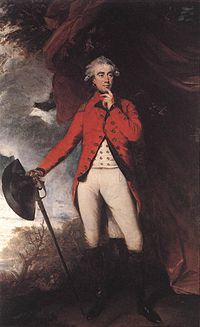Lord Rawdon
|
The Most Honourable The Marquess of Hastings KG PC |
|
|---|---|

The Marquess of Hastings as Governor-General of India by Joshua Reynolds
|
|
| Governor-General of the Presidency of Fort William | |
|
In office 4 October 1813 – 9 January 1823 |
|
| Monarch |
George III George IV |
| Preceded by | The Lord Minto |
| Succeeded by |
John Adam As Acting Governor-General |
| Governor of Malta | |
|
In office 22 March 1824 – 28 November 1826 |
|
| Monarch | George IV |
| Preceded by | Hon. Thomas Maitland |
| Succeeded by |
Alexander George Woodford As Acting Governor |
| Personal details | |
| Born |
9 December 1754 County Down, Kingdom of Ireland |
| Died | 28 November 1826 (aged 71) At sea off Naples |
| Nationality | British |
| Spouse(s) | Flora Campbell, 6th Countess of Loudoun (1780–1840) |
| Military service | |
| Allegiance |
|
| Service/branch | British Army |
| Rank | General |
| Commands | Commander-in-Chief of India |
| Battles/wars |
American War of Independence French Revolutionary Wars |
Francis Edward Rawdon-Hastings, 1st Marquess of Hastings, KG, PC (9 December 1754 – 28 November 1826), styled The Honourable Francis Rawdon from birth until 1762, as The Lord Rawdon between 1762 and 1783, and known as The Earl of Moira between 1793 and 1816, was an Anglo-Irish British politician and military officer who served as Governor-General of India from 1813 to 1823. He had also served with British forces for years during the American Revolutionary War and in 1794 during the French Revolutionary Wars. He took the additional surname 'Hastings' in 1790 in compliance with the will of his maternal uncle, Francis Hastings, 10th Earl of Huntingdon.
Marquess of Hastings by Hugh Douglas Hamilton (c.1801)
Marquess of Hastings, Governor-General of India by Joshua Reynolds (c.1812)
Francis Rawdon, Marquess of Hastings. Engraving. Fisher, Son & Co, London. 1829
Francis Rawdon, Marquess of Hastings by Henry Raeburn. 1813
Hastings was born at Moira, County Down, the son of John Rawdon, 1st Earl of Moira and Elizabeth Hastings, 13th Baroness Hastings. He grew up there and in Dublin, Ireland. He joined the British Army on 7 August 1771 as an ensign in the 15th Foot. (The going rate for purchasing a commission for this rank was ₤200.) He was at Harrow School and matriculated at University College, Oxford, but dropped out. He became friends there with Banastre Tarleton. With his uncle Lord Huntington, he went on the Grand Tour. On 20 October 1773, he was promoted to lieutenant in the 5th Foot. He returned to England to join his regiment, and sailed for America on 7 May 1774.
...
Wikipedia
